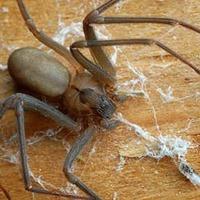Unfortunately, Iowa is home to several species of spiders. Davenport is no exception. Though there are at least ten different kinds of spiders that can regularly be found in Davenport, the two you most need to keep an eye out for are the black widow and the brown recluse. Most people know what a black widow spider looks like, but fewer are familiar with the brown recluse. With this guide, you can learn what to look for and what to do if you think you have brown recluse spiders in your home.
Brown Recluse Appearance
A brown recluse spider is, as the name suggests, brown. However, the exact shade of brown can be light or dark or sometimes even a yellowish brown. Their legs are typically a darker shade of brown than their bodies. Brown recluse spiders can also vary in size. Their legs can grow up to 1 ½” and their bodies are usually around 3/8”. Brown recluse spiders have a violin pattern on the upper part of their body.
Brown Recluse Habits
Brown recluse spiders are nocturnal, meaning they sleep and hide during the day and are active at night. They don’t build webs like other spiders but instead hunt for their prey. Brown recluse spiders are not naturally aggressive toward humans and will only bite if they feel threatened or trapped. They live in dark secluded areas such as attics, closets, or basements. They can hide inside furniture, bags, or boxes and are transported to new areas by hiding in these objects. They can go without food for weeks, making it possible for them to travel long distances without needing to come out for food.
Brown recluse spiders lay eggs in May through July. Female brown recluse spiders can lay several egg sacks, each containing around fifty eggs. This means that if you have a brown recluse in your home, it could multiply quickly and leave you with a dangerous infestation.
Brown Recluse Bites
Though brown recluse spiders aren’t aggressive, they do sometimes bite humans who get too close or scare them. A bite will typically swell and can be painful, itchy, and red. Bites often give a strong burning pain and can cause symptoms such as fevers, headaches, body aches, or rashes. Usually, the bites will go away on their own, but sometimes an infection can occur, requiring medical attention.
How to Prevent Brown Recluse Infestations
Because brown recluse spiders lay eggs during this time of year, it’s important to keep an eye out for them. If you see a brown recluse in your house, there’s a good chance they already laid eggs somewhere. The best thing you can do to prevent an infestation is to be vigilant. Keep your attic and basement as clean as possible so that you will see any spiders living in those areas. Be careful moving boxes or furniture which have been sitting in an unoccupied area as they could be housing brown recluse spiders.
What to Do if You See a Brown Recluse
If you see brown recluse spiders in your home, call Quick Kill for help. Quick Kill will complete an inspection of your house to determine how big the problem is. We know where to find egg sacks and spiders and will help you create a plan of elimination. Don’t risk letting hundreds of brown recluse spiders invade your home, call for professional help if you see brown recluse spiders. Here at Quick Kill, we have the experience necessary to solve the problem and the expertise to eliminate brown recluse spiders quickly, safely, and efficiently.

